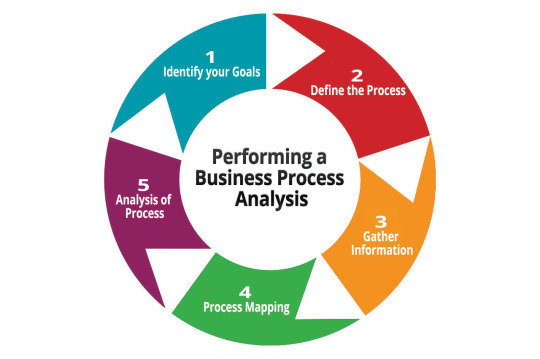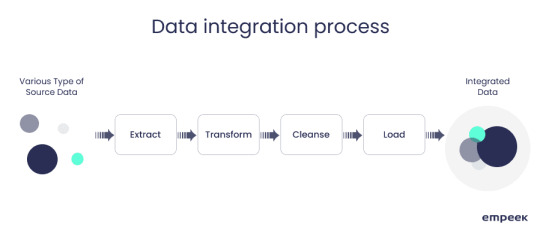#Data workflow
Text
The Role of Business Process Modeling Tools in Digital Transformation
In today's rapidly evolving business landscape, digital transformation has become more than just a buzzword; it's a strategic imperative for organizations looking to thrive in the digital age. At the heart of successful digital transformation initiatives lies the use of Business Process Modeling (BPM) tools. These tools play a pivotal role in helping organizations streamline operations, improve efficiency, and adapt to changing market dynamics. In this blog, we'll explore the crucial role that Business Process Modeling Tools play in driving digital transformation.

Understanding Digital Transformation
Digital transformation involves the integration of digital technologies into all aspects of business operations, fundamentally changing how organizations operate and deliver value to customers. It goes beyond simply adopting new technologies; it requires a fundamental shift in mindset, culture, and processes to embrace innovation and leverage technology to drive business outcomes.
The Evolution of Business Process Modeling Tools
Business Process Modeling Tools have evolved significantly over the years, from simple flowcharting tools to sophisticated platforms that offer advanced modeling, simulation, and automation capabilities. These tools enable organizations to visualize, analyze, and optimize their business processes in a structured and systematic manner.
Key Roles of BPM Tools in Digital Transformation
Process Discovery and Documentation: BPM tools enable organizations to document and analyze their existing business processes, providing a clear understanding of how work is currently being done. This process discovery phase is essential for identifying inefficiencies, bottlenecks, and opportunities for improvement.
Process Redesign and Optimization: Once processes are documented, BPM tools facilitate process redesign and optimization efforts. Organizations can use simulation and modeling features to experiment with different process configurations, identify optimal workflows, and streamline operations for maximum efficiency.
Automation and Integration: BPM tools play a crucial role in automating routine tasks and integrating disparate systems and applications. By automating manual processes, organizations can reduce errors, minimize delays, and improve overall productivity. Integration capabilities allow data to flow seamlessly between different systems, ensuring data consistency and accuracy.
Monitoring and Performance Management: BPM tools provide real-time visibility into process performance through monitoring and reporting features. Organizations can track key performance indicators (KPIs), identify performance trends, and proactively address issues to optimize process performance and drive continuous improvement.
Alignment with Business Objectives: BPM tools help align business processes with strategic objectives and goals. By mapping processes to business outcomes, organizations can ensure that every process contributes to the overall success of the organization and delivers value to customers and stakeholders.
Real-World Applications of BPM Tools in Digital Transformation
The role of BPM tools in digital transformation is evident across various industries and sectors:
In the banking and financial services sector, BPM tools enable organizations to streamline loan processing, improve customer onboarding experiences, and enhance regulatory compliance.
In healthcare, BPM tools facilitate the seamless exchange of patient information, optimize clinical workflows, and improve patient outcomes.
In manufacturing, BPM tools help optimize supply chain operations, reduce lead times, and improve product quality and delivery.
youtube
Conclusion
In conclusion, Business Process Modeling Tools play a crucial role in driving digital transformation initiatives across organizations. By providing a structured framework for process analysis, optimization, and automation, BPM tools enable organizations to streamline operations, enhance agility, and deliver superior customer experiences in today's digital era. As organizations continue to embrace digital transformation, BPM tools will remain indispensable assets for achieving operational excellence, driving innovation, and staying ahead of the competition.
SITES WE SUPPORT
Business Workflow Process - Wix
SOCIAL LINKS
Facebook
Twitter
LinkedIn
0 notes
Text
Best Underdog Regional Bird Pokemon Emergency Round 🗺️🪶
Round 5 - Final Match
Our Contestants:


This poll is part of an event that allows the early eliminees from the main tournament have more time in the spotlight!
I have no idea how this happened, but I found this discrepancy and don't want to just ignore it? The original final match should've been the second to last.
#uptunderdogtournament#pokemon#polls#best underdog regional bird#corvisquire#pidove#gen 8#my early-tournament record-keeping has strange incomplete bits that don't align with my workflow even a few weeks later#i...do not know what to do about that. I'm not even sure how I found the data for the original match given that i should've gotten it from#the neocities website where i keep track of all this. and if i did that then i should've seen this?????#i've never maintained any other tracking methods
20 notes
·
View notes
Note
HELP i submitted an album a bit ago by roy orbison (called “king of hearts”) and i accidentally put the songs in the language section of the forum, and i never realized it until i saw it on the spreadsheet AHHH
coming here to say that i’m embarrassed and i’m so sorry about this minor inconvenience
Don't worry about it! Things end up in the wrong boxes all the time, and it's always pretty clear what we're working with, so it's never actually an inconvenience!
#hyltta-asks#all album data gets double checked so nothing is ever automatically brought into our working sheet#so things like this dont really impact the workflow!
14 notes
·
View notes
Text
Experience the convergence of human intuition and AI ingenuity in web development. Catapult your digital presence with an impeccable blend of creativity and technology.
#Challenges and opportunities of combining human intelligence with AI in web design#Implementing emotional intelligence in AI-driven web development#Fine-tuning AI models for natural language processing in web development#Customizing AI-driven web solutions for individual user preferences#The impact of human oversight on AI-generated web content#Empowering developers with AI-assisted human-centric web design tools#Adapting to evolving user expectations through AI-enhanced web development#Leveraging AI for data-driven insights in human-centered web design#Maintaining brand authenticity in AI-driven web development#Exploring the future of collaborative AI-human web development workflows
2 notes
·
View notes
Text
(white knuckling my desk while dijkstra's algorithm slinks up slowly behind me, waiting to strike) I Need To Take Pokemon Go Less Seriously
#thinking about a workflow of using ingress intel total conversion community edition (IITC-CE) and tampermonkey as well as PoGOHWH#exporting pokestop/gym data as a JSON file#importing that data back into openstreetmap and using the aformentioned dijkstra's algorithm#to find an optimal route between every pokestop/gym on my university campus#and THEN exporting all that as a shapefile and downloading it on my phone for an on-the-go reference#(all of which i am not going to do)
2 notes
·
View notes
Text
How to Make Check Marks in Google Sheets
Improve your productivity and organization skills in Google Sheets with checkboxes! This powerful tool can enhance the visual appeal of your spreadsheets and streamline your workflow for task management and data analysis. Creating checkboxes is simple and straightforward. Whether you're a professional, student, or entrepreneur, incorporating checkboxes into your Google Sheets can make a huge impact on your productivity and efficiency.
5 notes
·
View notes
Text
Why Proactive Customer Service is Essential & How to Master It
Proactive customer service is going beyond waiting for questions. It's about anticipating customer needs and solving problems before they arise. Think of it as superhero customer service - stopping issues before they cause frustration.
0 notes
Text
Cutting Costs: How a Digital Document Management System (DMS) Reduces Operating Expenses
Introduction
In today's fast-paced business environment, organizations are continually seeking ways to improve efficiency, streamline operations, and reduce costs. One impactful solution that has gained prominence is the adoption of Digital Document Management Systems (DMS). This article explores how leveraging a DMS can lead to significant reductions in operating expenses while enhancing overall productivity.
Understanding Digital Document Management Systems (DMS)
Definition of DMS: A Digital Document Management System is a software solution that enables organizations to digitize, store, organize, and manage documents electronically, eliminating the need for physical paperwork.
Importance in Cost Reduction: DMS plays a vital role in cost reduction by minimizing paper usage, reducing manual tasks, and improving accessibility to information.
Key Components of a DMS
Automation: DMS automates document workflows, reducing the time and effort required for tasks such as document routing, approval processes, and notifications.
Centralized Storage: By storing documents digitally in a centralized repository, DMS eliminates the costs associated with physical storage, such as filing cabinets and off-site storage facilities.
Document Retrieval: Quick and efficient document retrieval within a DMS saves employee time, leading to increased productivity and reduced labor costs.
Cost-Saving Benefits
Paperless Operations: Transitioning to paperless operations with a DMS reduces expenses related to paper, printing, storage, and document distribution.
Reduced Administrative Burden: Automated workflows and streamlined processes reduce the need for manual intervention, minimizing administrative costs.
Improved Compliance: DMS helps organizations stay compliant with regulations and standards, avoiding costly penalties and legal issues.
Case Studies: Real Cost Savings
Explore case studies of organizations that have successfully implemented DMS solutions and achieved significant cost reductions across various departments.
Best Practices for Cost Optimization
Customization: Tailoring DMS features to specific business needs ensures optimal utilization and cost-effectiveness.
Training and Adoption: Providing comprehensive training and fostering user adoption ensures maximum ROI from DMS investments.
Security Considerations
Addressing security concerns such as data encryption, access controls, and regular audits ensures protection against data breaches and associated financial losses.
Conclusion
In conclusion, a Digital Document Management System (DMS) is a powerful tool for reducing operating costs in modern businesses. By automating workflows, centralizing document storage, and promoting paperless operations, organizations can achieve substantial cost savings while improving efficiency and compliance.
<a href="https://www.nte.ai/Blog/productivity/cutting-costs-how-a-digital-document-management-system-dms-reduces-operating-expenses/?utm_source=backlink&utm_medium=directory+submission&utm_campaign=organic ">Visit nte.ai</a>
#Cost Reduction#Digital Document Management#Operating Expenses#Efficiency#Paperless Office#Cloud Storage#Automated Processes#Time Savings#Resource Optimization#Eco-Friendly Solutions#Workflow Improvement#Data Security#Remote Access#Compliance#Scalability
0 notes
Text
Lab Analyzers Interfacing: Bridging the Gap Between Data and Action

In the dynamic landscape of laboratory operations, the seamless integration of Lab Analyzers Interfacing plays a pivotal role in transforming raw data into actionable insights. By bridging the gap between data generation and actionable outcomes, these interfaces facilitate efficient decision-making and enhance overall laboratory performance.
Seamless Data Integration: Seamless data integration is the cornerstone of effective lab analyzer interfacing. It enables disparate laboratory instruments and systems to communicate seamlessly, ensuring that data flows seamlessly throughout the laboratory ecosystem. With seamless data integration, laboratories can consolidate data from various sources, such as analyzers, LIS (Laboratory Information Systems), and EMR (Electronic Medical Records), enabling comprehensive analysis and reporting.
Real-time Analytics: Leveraging real-time analytics, laboratories can gain immediate insights into test results and performance metrics. By analyzing data as it is generated, laboratory professionals can identify trends, anomalies, and potential issues in real time, enabling proactive decision-making and intervention. Real-time analytics empower laboratories to optimize workflows, prioritize tasks, and deliver timely results to healthcare providers and patients.
Workflow Automation: Workflow automation streamlines laboratory processes by automating routine tasks and optimizing resource utilization. Through workflow automation, tasks such as sample handling, testing, and result reporting can be automated, reducing manual errors and accelerating turnaround times. By automating repetitive tasks, laboratories can enhance efficiency, improve throughput, and allocate resources more effectively.

Quality Assurance Measures: Maintaining quality assurance is paramount in laboratory operations to ensure the accuracy and reliability of test results. Lab analyzer interfacing enables the implementation of robust quality assurance measures, including instrument calibration, proficiency testing, and result validation. By enforcing stringent quality control protocols, laboratories can uphold the highest standards of accuracy and reliability in diagnostic testing.
Decision Support Systems: Integrated decision support systems empower laboratory professionals with actionable insights and recommendations based on data analysis. These systems leverage advanced algorithms and machine learning techniques to assist in result interpretation, diagnosis, and treatment planning. By providing evidence-based guidance, decision support systems enable laboratories to deliver more informed and personalized care to patients.
In conclusion, Lab Analyzers Interfacing plays a crucial role in bridging the gap between data generation and actionable outcomes in laboratory settings. Through seamless data integration, real-time analytics, workflow automation, quality assurance measures, and decision support systems, laboratories can enhance efficiency, accuracy, and overall performance, ultimately improving patient care and outcomes.
#Seamless Data Integration#Real-time Analytics#Workflow Automation#Quality Assurance Measures#Decision Support Systems
0 notes
Text
Demystifying Data Workflow A Comprehensive Overview
In today's data-driven world, organizations rely heavily on the efficient management and processing of data to drive decision-making, gain insights, and stay competitive. At the heart of this process lies the concept of data workflow, a structured sequence of steps and processes that govern the flow of data within an organization. In this comprehensive overview, we aim to demystify data workflow, explore its components, and highlight its importance in modern business operations.

Understanding Data Workflow
Data workflow refers to the systematic process of collecting, processing, analyzing, and disseminating data within an organization. It encompasses a series of interconnected steps and activities designed to ensure the smooth and efficient flow of data from its source to its destination.
At its core, data workflow involves defining the sequence of tasks, establishing dependencies between them, and automating processes wherever possible to streamline data management operations.
Components of Data Workflow
Data Acquisition: The first step in the data workflow process involves acquiring data from various sources, including internal databases, external data sources, sensors, and IoT devices. This may involve data extraction, ingestion, and cleansing to ensure data quality and integrity.
Data Processing: Once the data is acquired, it undergoes processing to transform it into a usable format for analysis and interpretation. This may include data transformation, normalization, aggregation, and enrichment to prepare the data for analysis.
Data Analysis: Data analysis involves applying statistical, mathematical, and computational techniques to derive insights, patterns, and trends from the data. This may include exploratory data analysis, predictive modeling, machine learning, and data visualization techniques to uncover meaningful insights.
Decision Making: The insights generated from data analysis are used to inform decision-making processes within the organization. This may involve strategic decisions related to business operations, marketing campaigns, product development, and customer engagement based on the insights derived from the data.
Data Visualization and Reporting: Data visualization and reporting play a crucial role in communicating insights and findings derived from the data analysis process. This may involve creating dashboards, charts, graphs, and reports to present data in a visually appealing and understandable format for stakeholders.
Data Storage and Management: Effective data storage and management are essential components of the data workflow process. This may involve storing data in secure, scalable, and accessible repositories such as data warehouses, data lakes, or cloud storage solutions.
Importance of Data Workflow
The importance of data workflow cannot be overstated in today's business landscape. Here are some key reasons why data workflow is essential:
Efficiency: Data workflow streamlines data management processes, reduces manual intervention, and improves operational efficiency within the organization.
Accuracy and Consistency: A well-defined data workflow ensures data accuracy, consistency, and reliability, providing stakeholders with confidence in the integrity of the data.
Decision Making: Data workflow facilitates data-driven decision-making by providing timely insights and actionable information to support strategic and operational decisions.
Innovation and Growth: By harnessing the power of data workflow, organizations can unlock new opportunities for innovation, optimize business processes, and drive sustainable growth.
Competitive Advantage: Organizations that effectively leverage data workflow gain a competitive advantage in the marketplace by responding quickly to changing market dynamics, identifying emerging trends, and meeting customer needs more effectively.
youtube
Conclusion
In conclusion, data workflow is a critical component of modern business operations, enabling organizations to harness the power of data to drive decision-making, gain insights, and achieve strategic objectives. By understanding the components and importance of data workflow, organizations can unlock the full potential of their data assets and gain a competitive edge in today's data-driven world. Demystifying data workflow is the first step towards building a data-driven culture and realizing the transformative power of data in driving business success.
SITES WE SUPPORT
Business Workflow Process - Wix
SOCIAL LINKS
Facebook
Twitter
LinkedIn
1 note
·
View note
Text
Efficiency and Accuracy: The Goals of Laboratory Management

Laboratory Management is the backbone of any healthcare institution, ensuring that tests are conducted accurately and efficiently to provide timely diagnoses and treatment plans. In this blog post, we'll delve into the essential aspects of Laboratory Management, focusing on Specimen Tracking, Quality Control, Instrument Calibration, Workflow Automation, and Data Analysis.
Specimen Tracking: Specimen tracking is a critical component of Laboratory Management, as it involves the accurate identification and monitoring of specimens throughout the testing process. By implementing robust specimen tracking systems, laboratories can ensure that samples are correctly labeled, tracked, and processed, minimizing the risk of errors and ensuring reliable test results.
Quality Control: Maintaining quality control standards is essential to uphold the accuracy and reliability of laboratory test results. Laboratories implement stringent quality control measures to monitor and evaluate the performance of tests, equipment, and personnel. This ensures that testing processes consistently meet established quality standards, leading to accurate and reliable results.
Instrument Calibration: Proper instrument calibration is vital to ensure the accuracy and reliability of laboratory equipment. Calibration involves adjusting instruments to align with known standards, ensuring that measurements are precise and consistent. Regular calibration of laboratory instruments minimizes errors and ensures the accuracy of test results, contributing to the overall quality of laboratory services.

Workflow Automation: Workflow automation streamlines laboratory processes by automating repetitive tasks and standardizing workflows. Automation improves efficiency by reducing manual errors, accelerating turnaround times, and optimizing resource utilization. By implementing workflow automation solutions, laboratories can enhance productivity, reduce costs, and improve overall operational efficiency.
Data Analysis: Data analysis plays a crucial role in Laboratory Management, as it involves interpreting test results and deriving meaningful insights from data. Advanced data analysis tools enable laboratories to identify trends, detect abnormalities, and make informed decisions regarding patient care. By harnessing the power of data analysis, laboratories can improve diagnostic accuracy, optimize treatment plans, and enhance patient outcomes.
In conclusion, Laboratory Management plays a pivotal role in ensuring the efficiency and accuracy of laboratory testing processes. By prioritizing Specimen Tracking, Quality Control, Instrument Calibration, Workflow Automation, and Data Analysis, laboratories can achieve their goals of providing timely, accurate, and reliable test results, ultimately contributing to improved patient care and outcomes.
0 notes
Text
Streamline operations with our outsourced data management solutions. Secure, organized, and scalable services for enhanced productivity. Get started today!
0 notes
Text
Tally-VTiger Integration Revolutionizes Accounting And CRM
The integration of Vtiger CRM with Tally represents a significant advancement in business technology, offering enhanced capabilities for small and medium enterprises (SMEs) seeking automation and growth.

By combining the strengths of Vtiger's comprehensive CRM functionalities with Tally's robust accounting features, businesses can achieve a holistic view of their operations. This integration enables smoother collaboration between sales, marketing, and finance teams, ensuring seamless data flow and improved collaboration across departments.
Moreover, the integration empowers businesses with advanced reporting and analytics, allowing them to monitor key performance indicators (KPIs) effectively. With consolidated insights into sales, financial performance, and customer behavior, organizations can make data-driven decisions and optimize strategies for business expansion.
This integrated approach not only saves time and reduces manual effort but also fosters a more efficient and agile business environment. To delve deeper into how Vtiger CRM and Tally integration can drive your business forward, click on the following link:
Tally-VTiger Integration Revolutionizes Accounting And CRM
OR
Visit Our Website: Antraweb Technologies Pvt. Ltd.
#tallyprime#Tally Integrated Vtiger CRM#Tally-Vtiger Integration#CRM and Accounting Integration#Tally-Vtiger CRM Integration#Automating Tally’s workflow#CRM Automation#Real-time Data Integration#Efficient Data Management
0 notes
Text
10 Effective SEO Tips for Web Developers

Introduction:
Are you a budding web developer eager to enhance your website's visibility and attract more visitors from search engines? Search Engine Optimization (SEO) is the key to improving your website's ranking and driving organic traffic. In this blog post, we'll share 10 effective SEO tips specifically designed for web developers and Web development strategies to help you optimize your websites and boost your online presence.
Optimize Page Titles and Meta Descriptions:
Make sure to include relevant keywords in your page titles and meta descriptions. These elements provide valuable information to search engines and users about the content of your web pages.
Create SEO-Friendly URLs:
Use descriptive and keyword-rich URLs for your web pages. A clear and concise URL structure not only improves user experience but also makes it easier for search engines to understand and index your content.
Optimize Heading Tags:
Use proper heading tags (H1, H2, H3, etc.) to structure your content. Heading tags help search engines understand the hierarchy of your content and highlight the most important topics on your web pages.
Optimize Images for SEO:
Optimize your images by using descriptive filenames and alt text. This helps search engines better understand the content of your images and can improve your website's visibility in image search results.
Improve Website Speed and Performance: Page speed is a crucial factor for both user experience and SEO. Optimize your website's performance by minimizing loading times, optimizing images, and reducing server response times.
Ensure Mobile-Friendly Design:
With the increasing use of mobile devices, it's important to ensure that your website is mobile-friendly. Use responsive design techniques to ensure that your website looks and functions well on all devices.
Optimize Website Structure and Navigation:
Create a clear and intuitive website structure with logical navigation. This makes it easier for users to find what they're looking for and helps search engines crawl and index your content more effectively.
Publish High-Quality, Relevant Content: Content is king when it comes to SEO. Create high-quality, informative, and engaging content that provides value to your users. Focus on creating content that answers their questions and solves their problems.
Regularly Update Your Website:
Keep your website's content fresh and up-to-date by regularly publishing new content and updating existing pages. This not only keeps your users engaged but also signals to search engines that your website is active and relevant.
Monitor and Analyse Your Website's Performance:
Use tools like Google Analytics to track and analyse your website's performance. Pay attention to key metrics such as organic traffic, keyword rankings, and conversion rates. Use this data to identify areas for improvement and adjust your SEO strategy accordingly.
By following these SEO tips for web developers, you can improve your website's visibility, attract more organic traffic, and ultimately, achieve better results online. Whether you're considering enrolling in a web development course or seeking training at a reputable institute or training centre, mastering SEO optimization techniques and web development strategies is essential for success in today's competitive digital landscape. Happy optimizing!
Suggested Blogs:
C++ development workflow
career in website designing
data structure optimization
#data structure optimization#C++ development workflow#career in website designing#SEO optimization techniques#Web development strategies
0 notes
Text
Versatile Software Solution for Efficient Organization Management

PrideStudio is a versatile software solution designed for various organizations, boasting a user-friendly interface and robust data recovery tools. With over 20,000 global users across 100+ industries, it offers strategic KPI visualization dashboards and real-time data access. Key features include automation of departmental activities, enhanced workflow transparency, and electronic data security. The software's customization options, integration capabilities, and notification systems make it a reliable choice for businesses seeking efficiency and accountability.
For more Information visit: PrideStudio (pridesys.com)
Contact us:
E-mail: [email protected];
Phone: +8801550000003-8, 01550000035
#Versatile software solution#User-friendly interface#Data recovery tools#KPI visualization dashboards#Real-time data access#Departmental activities automation#Workflow transparency#Electronic data security#Customization options#Integration capabilities
0 notes
Text
How to Get Excellent at Proactive Customer Service and Why It's Important

Investigate and ascertain the necessity of proactive customer service in the modern company environment. Find out how to transform your organization by becoming an expert in proactive customer service.
#business experience management#customerexperience#workflow automation software#customer experience management#customer data platform
0 notes